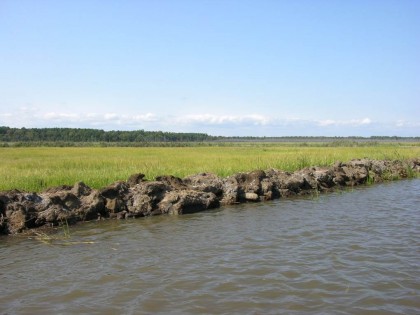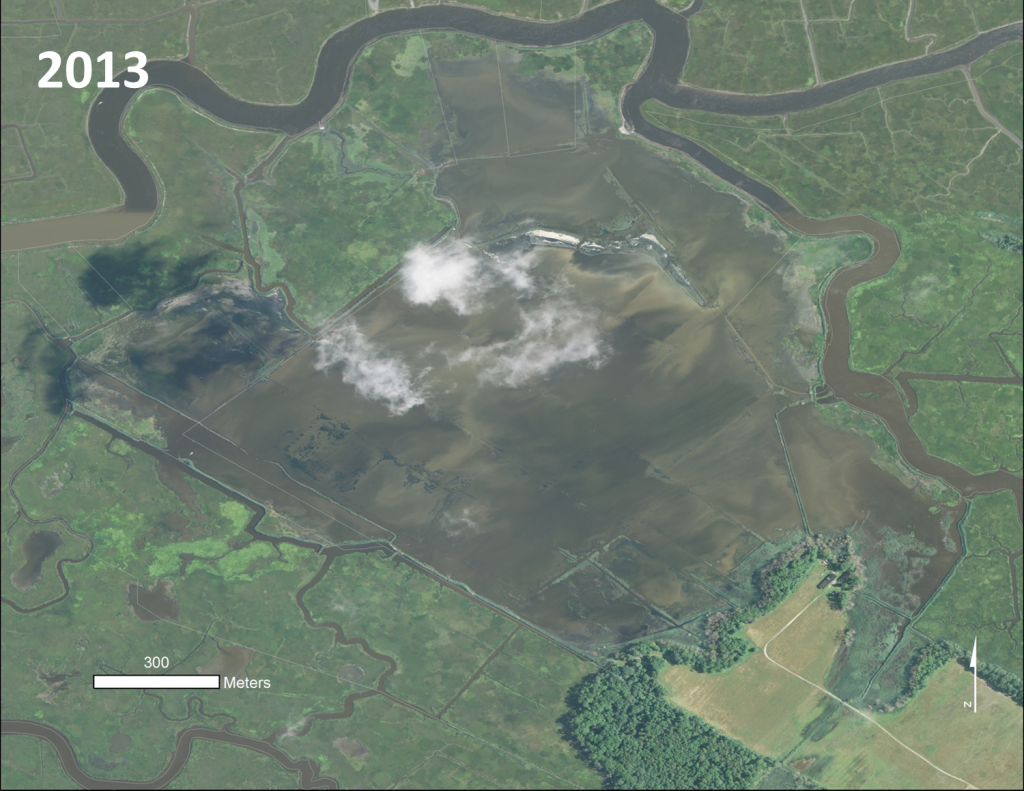
Impounding tidal marshes for farming was one of the first activities of early settlers on the Delaware Bay. The practice goes back 400 years and resulted in very productive farms for vegetables and grains, along with salt hay in more salty locations.
During the course of the 20th century, maintaining diked farmland gradually declined due to a variety of economic, social and environmental factors. Nonetheless, we still had a few salt hay farms right up until the recent hurricane era of Irene, Ike, and Sandy (which I will mention again below).
The history of diking tidal marshes for farming in the Delaware Bay has had consequences. Normally a tidal marsh can respond to ongoing sea level rise by capturing suspended sediment delivered by tides to slightly raise its own elevation a little bit at a time.
Diked wetlands are not flooded as frequently and are deprived of this natural nourishment. In addition, because diked marshes become drier, they experience more decomposition of the underlying peat. Add ongoing vegetation harvest to this equation and the result is that impounded marshes become lower in elevation over time.
So much lower in fact, that often the impounded marsh will find itself at an elevation that is too low to support vegetation at all if the dikes holding back the tides should breach.
Unfortunately now, and as long as the practice has existed, breaches of the fragile earthen dikes made of surrounding marsh mud have been all too common. When storms hit and/or active maintenance lapses, dikes breach.
The records of meadow banking companies, which were joint ventures of marsh-farming landowners dating back to the 1700’s to maintain dike networks, tell the tale of year in year out battles with dike breaches. Many of these companies dissolved when dike repairs became too costly or too frequently needed.
For an example of such a breach, see the photos below of the last salt hay farm in Cape May County. This was a vast 300+ acre expanse of high marsh vegetation dominated by salt hay (Spartina patens). Due to the subsidence process described above, this farm was well below sea level when Hurricane Sandy arrived.

Use the slider to toggle views.
The practice of diking turns a normally resilient system into a very brittle system at the edge of collapse. The legacy of salt hay farming can be seen in nearly all the marshes of the Delaware Bay, with three general outcomes:
•Being totally lost to open water.
•Becoming sparsely vegetated mudflats.
•Becoming revegetated with mononotonous stands of tall form Spartina alterniflora (low marsh) – the best case scenario.
Much tidal marsh as been lost through this process but the biggest loser is high marsh and high marsh dependent species such as black rail, northern harrier and saltmarsh sparrow. During the 20th century, The bay quickly went from being dominated by salt hay farms with high marsh vegetation to being dominated entirely by low marsh vegetation.
The natural marshes of the bay were a mosaic of both. For an example of such a mosaic, see the next photo, which is a part of the bay’s salt marsh that was never diked. The light green vegetation is high marsh and the dark green is low marsh.
The bottom line for conservation now is that most tidal marshes on the Delaware Bay are at risk – but not due to storms or sea level rise. The poor condition of Delaware Bay tidal marshes is the result of past management practices and subsequent neglect.
This is an important distinction because it can empower us to take action and resume an active role in determining the fate of our tidal marshes. This active role requires restoration of marshes in order to help them recover from the decades and centuries of sediment deficit they accrued during the impoundment era.
Salt marshes have never been more important as we seek ways to buffer the coastline from storms and improve the commercial and recreational fisheries that depend on this ecosystem. Restoration can ensure that marshes can continue to provide these services well into the future.